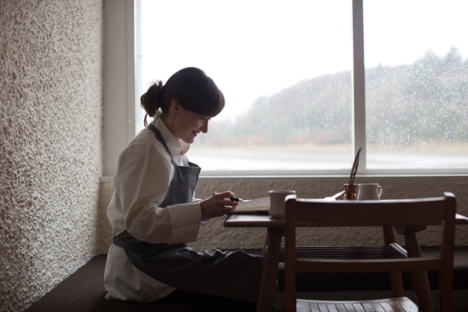
Ones to watch: Pam Brunton
Pam Brunton left a philosophy degree behind to pursue her love of cooking. After stints at Restaurant Tom Aikens, The Greenhouse and In De Wulf in Belgium, she’s returned home to chart a new path for Scottish food at Inver – her restaurant on the shores of Loch Fyne.
Ones to watch: Pam Brunton
Pam Brunton left a philosophy degree behind to pursue her love of cooking. After stints at Restaurant Tom Aikens, The Greenhouse and In De Wulf in Belgium, she’s returned home to chart a new path for Scottish food at Inver – her restaurant on the shores of Loch Fyne.
View more from this series:
Ones to watchLoch Fyne is the longest of Scotland’s sea lochs – it stretches a colossal forty miles inland from the Sound of Bute to Achadunan, a small hamlet in the foothills of the Trossachs. You probably know the name courtesy of the restaurant chain that adopted it, but the loch itself is famous for some of the finest seafood in Scotland, as well as some typically Hebridean vistas.
Ancient Scottish monuments stand proudly along its length; on the south shore of the loch is Old Castle Lachlan, a once mighty fifteenth century castle that has long since been humbled by the passage of time. Clan MacLachlan moved to a new castle in 1790, and when they left, the ivy promptly moved in, sprawling over the old stone like a lush green carpet. If you’re climbing among the castle ruins and you peer across the lake to the south, you’ll see a cottage, whitewashed and glowing among the trees. This is Inver – a restaurant with rooms that is fast becoming a new monument to Scottish cuisine.
Inver is the culmination of a journey for Pam Brunton – she was born in Scotland and raised on the east coast, in Carnoustie just outside Dundee. ‘Scotland’s second most famous golf town!’ she laughs. ‘My mum prepared home-cooked meals most nights of the week, but we also had Findus crispy pancakes and Linda McCartney lasagnas, because I decided I was a vegetarian when I was thirteen. So my mum said, ‘that's fine, but you're not eating rubbish and I'm not cooking two meals for the family. Your father won't eat vegetables!’ So I started cooking in my teens because of that – because she normalised cooking I suppose.’
It was a relatively normal foodie upbringing, but already there was the seed of something that would grow in Pam and her approach to food. Her mother was raised in Zimbabwe, and always grew her own vegetables, battling with Scotland’s inhospitable east coast but often coming out on top. ‘She grew sweetcorn outside, which I find remarkable!’ says Pam. ‘I guess, as a result, you grow up understanding the flavour of real produce. You can taste the difference. I knew what sweetcorn straight off the plant tasted like. It was always a moment of great excitement when we got a ripe cob of sweetcorn.’
Though Pam never had any intention of becoming a chef, she recognises the importance of those childhood experiences a little more now. ‘There was nothing in my early years that said food was going to be significant,’ she says, ‘but then of course, it happens and you look back and think, ‘okay, I can see who I am; I’ve got value in these things’.’
Pam left for Edinburgh University at eighteen to study philosophy, but quickly found that university life didn’t suit her. She quit in her second year and moved to Kyle of Lochalsh – a small town that sits at the gateway to the Isle of Skye – and worked her way around a few bar jobs. ‘I got fired for having a good time with the locals and giving out free pints,’ she chuckles. ‘I think the official reason was ‘attitude to management!’ Eventually a friend roped her into cooking at a local seafood restaurant, and she discovered a talent she didn’t realise she had. ‘It was the first job where I had an identity; I can say I’m a chef and people will know what I mean.
‘So, that job stuck and I’ve never been fired from a job since!’
Pam’s career since has spanned a huge range of roles and countries. She moved to Glasgow soon after and worked at the fashionable Art House Hotel, alongside none other than Isaac McHale, of Young Turk and The Clove Club fame. From there, Pam’s ambition took her to London and France – she worked at Restaurant Tom Aikens, the Greenhouse in Mayfair and with Marco Pierre White Restaurants before a ten month stint at Le Moulin de L’Abbaye in Brantôme in the Dordogne.
It’s an impressive resume, for sure, but Pam’s chef roles are only a part of her career in food. After eight years in high-end restaurant kitchens, Pam returned to university and completed a Masters degree in Food Policy at City University in London, then spent three-and-a-half years putting her newfound knowledge and skills to work for Sustain and The Soil Association – two charitable groups who campaign for more sustainable food environments. Instead of manning a kitchen section, Pam found herself teaching prisoners how to cook, campaigning for better food and farming practices, and arguing with the head of the National Farmer’s Union on Newsnight.
Still, Pam and her partner Rob both harboured a dream to open their own restaurant, and eventually decided the time was right to leave London. The search for what would eventually become Inver led them on a merry chase around Europe, to Pam’s first head chef role on the Isle of Iona, then to stints at Noma in Copenhagen, Fäviken in Jämtland, Sweden, and the much-missed In De Wulf in Belgium. ‘The restaurant we worked in on the Isle of Iona was closed for four months over the winter, so we used that time to go and work in other places.’
‘While we were in Belgium, a friend messaged me to ask if we were still looking for a site in Scotland, because this restaurant was about to go on the market,’ Pam continues. ‘By coincidence, we were about to come home for Rob's granny’s funeral, so we took the opportunity to nip up and view the place.’ When they arrived on the south shore of Loch Fyne, they saw Old Castle Lachlan, with its verdant ivy carpet, and a whitewashed restaurant set against the trees. ‘When we saw Inver, we said ‘if it’s not here, I don’t know where it is.’
In Pam’s mind, Inver isn’t just about serving people good food. It’s an encapsulation of everything around it – the people, the places and the stories. She makes a point of working with suppliers like Kate Glasgow – a local bed and breakfast owner and part-time nurse who also grows vegetables for the restaurant. Pam and Rob spotted Kate’s polytunnels on their very first drive to see the restaurant – now she regularly shows up at the back door with a box of fresh veggies. Then there’s ‘Duncan the seaweed guy’ – a marine biologist by training who is also a seaweed fanatic on the side. ‘He gave himself an iodine overdose from eating too much seaweed,’ Pam laughs. ‘He’s since moved away to a little island, and we’ve been buying his seaweed ever since.’
Almost everything on the menu comes from within a short radius of the restaurant, whether it’s supplies from Kate or Duncan, sea herbs and vegetables from the shores of the loch, or beautiful Scottish seafood. Just as her mum’s sweetcorn plant provided bursts of excitement for her growing up, now Pam is the one enthralling her guests with Scottish halibut – sustainably farmed on the nearby Isle of Gigha and served with wild leeks, mussels and a smoky mussel butter – oysters from Loch Creran, or Loch Fyne langoustines served with rapeseed mayo and sourdough.
‘We moved here because we wanted to be somewhere where the food would connect with the landscape and we could tell a story,’ says Pam. ‘Wanting to represent the land around us and the amazing people we work with is as much of a driving force as the amazing things I encountered at Noma or Fäviken. Of course there were many amazing things going on in those places, but that’s just one part of the package really; I try not to be driven by just one influence. I think we’re very conscious of drawing on all of our experience and that’s what makes Inver such a special place.’
Now into its fourth year, Pam admits it’s been tough going at times, but this is the first year the business has felt a little more stable. She and Rob have built a number of bothies on site so people can dine and stay overnight, and Inver is fast building a reputation as one of Scotland’s most exciting restaurants. Michelin has called in, she says, but the prospect of a star doesn’t affect her goal. ‘I want to honour the people that supply us and that work with us,’ she says. ‘I know the skills I have, and I know the produce we use – I have more faith in it now than I ever have at any point in the last four years. I know what we do is good.’ On current form, Inver is surely a monument that'll stand the test of time.


